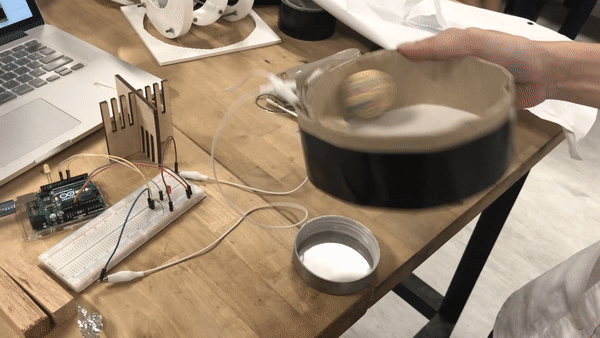This week, we learnt about electronics and how to create inputs & outputs using Arduino, cables, breadboard, LEDs, resistors and wires.
We managed to light up the LED and learnt how to change the speed and intervals of the LED blinking while connecting the Arduino to our laptops. After a short exercise, Andreas gave us an assignment, we had to design a solution to light up the LED without using our hands.
Currently, the LED lights up because we are using our hands to connect both wires. What can we build to bridge that connection and turn the LED on and off without hands? We were given some materials (pins/styrofoam board/rubber bands/etc) for a start but all of us were still clueless so when Andreas said we could use the tools in the workshop, we started hunting for any possible, usable props and items.
We began by throwing ideas around - We were thinking about what can generate kinetic movements - rubber bands, wind, water, ball, etc. After we decided on the 'moving ball' idea, Javier decide to create a 'bowl' using styrofoam, duct tape and brown papers. Preseetha and I were looking around for a ball but to no avail so we created one using paper, nails(for weight), tapes and rubber bands.
One funny thing that happened:
Javier was asking for aluminium foil to work as a conductor but the workshop did not have any and then I remembered I cooked salmon that day, wrapped it in aluminium foil and brought it to the studio. Andreas was like NO, YOU CAN'T USE IT, NO FISHY SMELL IN THE WORKSHOP. But I grabbed it, washed it and Javier used it lol, no fishy smell, just detergent fragrance.


How it works: When we spin the bowl, the ball will go round and round and when it hits the sweet spot, both wires will connect and light up the LED, it goes on & off as the ball spins in the bowl.
Thoughts: We think its quite successful but still felt that it could be improved. We finished our first experiment in about 45 mins, but feeling quite unsatisfied, we decided to explore further.
This is the second experimentation:
Thoughts: Also a success although this time we're using body movement to 'trigger' the metal weight and it acts like a pendulum. Andreas suggested that we place the model on the table and while experimenting, we realise that when the weight goes up and down, it works better than swinging left to right.
This is the third experimentation:
Thoughts: Much better!

Project by: Preseetha Venkatramanan, Javier Jauhari & Ace Chia.













No comments
Post a Comment